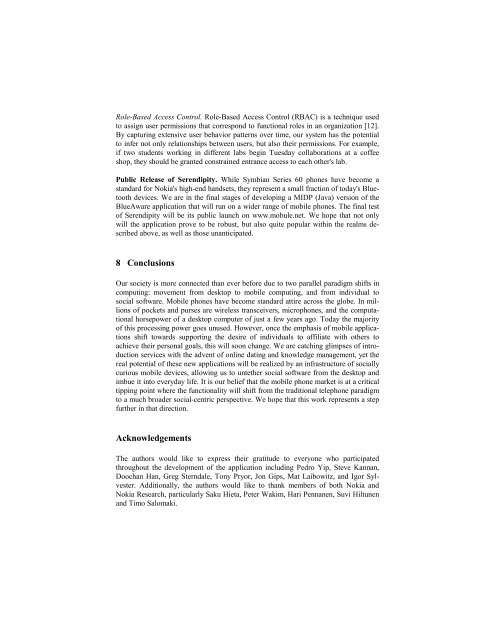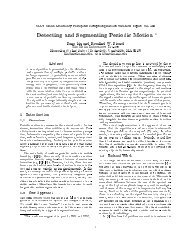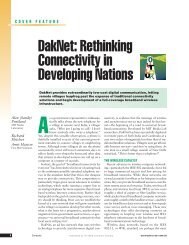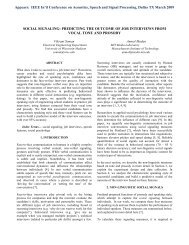Social Serendipity: Proximity Sensing and Cueing - Human ...
Social Serendipity: Proximity Sensing and Cueing - Human ...
Social Serendipity: Proximity Sensing and Cueing - Human ...
Create successful ePaper yourself
Turn your PDF publications into a flip-book with our unique Google optimized e-Paper software.
Role-Based Access Control. Role-Based Access Control (RBAC) is a technique used<br />
to assign user permissions that correspond to functional roles in an organization [12].<br />
By capturing extensive user behavior patterns over time, our system has the potential<br />
to infer not only relationships between users, but also their permissions. For example,<br />
if two students working in different labs begin Tuesday collaborations at a coffee<br />
shop, they should be granted constrained entrance access to each other's lab.<br />
Public Release of <strong>Serendipity</strong>. While Symbian Series 60 phones have become a<br />
st<strong>and</strong>ard for Nokia's high-end h<strong>and</strong>sets, they represent a small fraction of today's Bluetooth<br />
devices. We are in the final stages of developing a MIDP (Java) version of the<br />
BlueAware application that will run on a wider range of mobile phones. The final test<br />
of <strong>Serendipity</strong> will be its public launch on www.mobule.net. We hope that not only<br />
will the application prove to be robust, but also quite popular within the realms described<br />
above, as well as those unanticipated.<br />
8 Conclusions<br />
Our society is more connected than ever before due to two parallel paradigm shifts in<br />
computing: movement from desktop to mobile computing, <strong>and</strong> from individual to<br />
social software. Mobile phones have become st<strong>and</strong>ard attire across the globe. In millions<br />
of pockets <strong>and</strong> purses are wireless transceivers, microphones, <strong>and</strong> the computational<br />
horsepower of a desktop computer of just a few years ago. Today the majority<br />
of this processing power goes unused. However, once the emphasis of mobile applications<br />
shift towards supporting the desire of individuals to affiliate with others to<br />
achieve their personal goals, this will soon change. We are catching glimpses of introduction<br />
services with the advent of online dating <strong>and</strong> knowledge management, yet the<br />
real potential of these new applications will be realized by an infrastructure of socially<br />
curious mobile devices, allowing us to untether social software from the desktop <strong>and</strong><br />
imbue it into everyday life. It is our belief that the mobile phone market is at a critical<br />
tipping point where the functionality will shift from the traditional telephone paradigm<br />
to a much broader social-centric perspective. We hope that this work represents a step<br />
further in that direction.<br />
Acknowledgements<br />
The authors would like to express their gratitude to everyone who participated<br />
throughout the development of the application including Pedro Yip, Steve Kannan,<br />
Doochan Han, Greg Sterndale, Tony Pryor, Jon Gips, Mat Laibowitz, <strong>and</strong> Igor Sylvester.<br />
Additionally, the authors would like to thank members of both Nokia <strong>and</strong><br />
Nokia Research, particularly Saku Hieta, Peter Wakim, Hari Pennanen, Suvi Hiltunen<br />
<strong>and</strong> Timo Salomaki.






